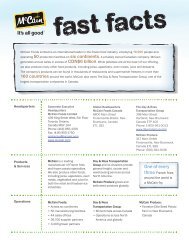From the Ground Up - McCain Foods Limited
From the Ground Up - McCain Foods Limited
From the Ground Up - McCain Foods Limited
You also want an ePaper? Increase the reach of your titles
YUMPU automatically turns print PDFs into web optimized ePapers that Google loves.
<strong>McCain</strong> gives out free<br />
samples to launch its retail<br />
products in England, c.1976.<br />
The ability to make decisions quickly gave <strong>McCain</strong> a<br />
big advantage over its competitors. In <strong>the</strong> mid-1980s, <strong>the</strong><br />
Scarborough and Whittlesey plants had a severe problem<br />
with potato blight, a devastating disease in which a fungus<br />
causes internal rot. In <strong>the</strong> past, it has destroyed entire potato<br />
crops and led to mass starvation, as with <strong>the</strong> Irish potato<br />
famine of <strong>the</strong> 1840s, when one million people died.<br />
The factories could control <strong>the</strong> advance of <strong>the</strong> disease<br />
by using fans in <strong>the</strong> potato storage areas, but <strong>the</strong>y didn’t<br />
have enough of <strong>the</strong>m. “I remember going with Allison to<br />
see Mac to tell him we needed to increase <strong>the</strong> fan capacity<br />
promptly, and it would cost us ₤275,000,” says Finn. “Mac<br />
understood immediately, and said, ‘Let me call Harrison<br />
to give him a chance to have his input.’ He called and, ten<br />
minutes later, said, ‘Okay guys, go ahead.’”<br />
The building of <strong>the</strong> British and Australian businesses set a pattern that would be<br />
followed wherever in <strong>the</strong> world <strong>McCain</strong> decided to go. The first step is to establish a<br />
market by importing <strong>McCain</strong> products to sell to <strong>the</strong> food service industry. Then, if<br />
<strong>the</strong> market potential is sufficient and good potatoes can be grown at a competitive<br />
cost, <strong>McCain</strong> ei<strong>the</strong>r builds or buys a factory to produce locally. The final step is to<br />
enter <strong>the</strong> retail market.<br />
<strong>McCain</strong> entered <strong>the</strong> British retail market in 1976. Since <strong>the</strong>n, its retail french fry<br />
business has been hugely successful. Happily for <strong>McCain</strong>, <strong>the</strong> British supermarkets<br />
were moving to central warehousing systems ra<strong>the</strong>r than requiring processors to ship<br />
products directly to individual stores. This made it easier for a new competitor to<br />
enter <strong>the</strong> market because it would not have to acquire a fleet of trucks to deliver to<br />
hundreds of locations all over <strong>the</strong> United Kingdom.<br />
Mac gives credit to Roger Lillyman, his first marketing director, for establishing<br />
a successful retail business in <strong>the</strong> United Kingdom. The big breakthrough occurred<br />
in 1978 when <strong>McCain</strong> GB launched Oven Chips, <strong>the</strong> British version of <strong>the</strong> product<br />
known in Canada as Superfries. Although market research for fries that could be<br />
baked in <strong>the</strong> oven wasn’t favourable, <strong>McCain</strong> had seen <strong>the</strong> success of <strong>the</strong> product in<br />
Canada and had confidence consumers would accept it once <strong>the</strong>y understood <strong>the</strong>y<br />
could have deep-fried taste without <strong>the</strong> inconvenience, smell, and danger<br />
of deep-frying at home.<br />
<strong>McCain</strong> succeeded in retail through consistent advertising, aggressive<br />
selling, and product quality. By focusing on one product, Oven Chips,<br />
<strong>McCain</strong> stole <strong>the</strong> frozen chip market away from its competitors, including<br />
Birds Eye, Findus, and Ross. Steady innovation helped increase both<br />
<strong>the</strong> chip market and <strong>McCain</strong>’s share of it. The company relaunched Oven<br />
Chips on a regular basis with new cuts and fresh marketing. And, in 1985,<br />
it introduced Micro Chips, which could be prepared in <strong>the</strong> microwave.<br />
During <strong>the</strong> late 1980s and early 1990s, although <strong>McCain</strong>’s retail business<br />
continued to grow, private labels were growing faster and overall<br />
market growth was declining. <strong>McCain</strong> revolutionized <strong>the</strong> market again<br />
in 1997 by introducing <strong>McCain</strong> Home Fries, a thick-cut chip that used<br />
coating technology to deliver a crispy outside and a moist, fluffy texture<br />
inside, just like a British homemade chip.<br />
Home Fries were an overnight success. Despite an initial dip in Oven<br />
Chip sales at <strong>the</strong> time of <strong>the</strong> launch, <strong>the</strong> total sales of Home Fries and<br />
Oven Chips by 2007 was almost two and half times <strong>McCain</strong>’s chip sales<br />
before <strong>the</strong> launch of Home Fries. Today <strong>McCain</strong> has more than a 50 percent<br />
share of <strong>the</strong> British frozen chip market, a share five times bigger than<br />
<strong>the</strong> next brand. Private labels are <strong>McCain</strong>’s main competition.<br />
“<strong>McCain</strong> in Great Britain today is primarily a potato business,” says<br />
Nick Vermont, “but this hasn’t been for lack of trying o<strong>the</strong>r product<br />
categories.” Indeed, buoyed by <strong>the</strong> success of Oven Chips, <strong>McCain</strong> GB<br />
tried to establish itself as a broad frozen food business during <strong>the</strong> 1980s.<br />
It launched a range of products, including pizza, ready meals, breakfast<br />
meals, frozen orange juice, desserts, fish products, and snack foods. Some<br />
of <strong>the</strong>se categories were already successful in Canada. But <strong>the</strong> same competitors<br />
that <strong>McCain</strong> had quickly beat in <strong>the</strong> french fry market were well<br />
established and committed to <strong>the</strong>se categories – and better prepared for<br />
ano<strong>the</strong>r attack from <strong>McCain</strong>. While <strong>McCain</strong> was a brand leader in <strong>the</strong><br />
retail market for frozen pizza for many years, its o<strong>the</strong>r categories were not<br />
as successful and have since been dropped.<br />
In 1983, <strong>McCain</strong> GB acquired Britfish, a frozen fish supplier in <strong>the</strong><br />
Yorkshire city of Hull. However, <strong>the</strong> competition from Birds Eye was too<br />
strong and <strong>McCain</strong> decided to get out of <strong>the</strong> retail frozen fish market.<br />
58 <strong>From</strong> <strong>the</strong> g round up<br />
crossing <strong>the</strong> AtlA ntic 59<br />
The evolution of Oven Chips: (top to<br />
bottom) 1985, <strong>the</strong> first health positioning<br />
– 40 percent less fat than deep frying; 1991,<br />
<strong>the</strong> focus is on 5 percent fat and <strong>the</strong> use of<br />
sunflower oil; 1998 sees a broader health<br />
message; 2006, <strong>the</strong> It’s All Good campaign<br />
– just potatoes and sunflower oil.






